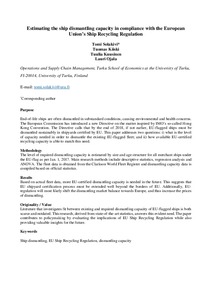Estimating the ship dismantling capacity in compliance with the European Union’s Ship Recycling Regulation
Tomi Solakivi; Tuomas Kiiski; Tuulia Kuusinen; Lauri Ojala
https://urn.fi/URN:NBN:fi-fe2021042717795
Tiivistelmä
Purpose
End-of-life ships
are often dismantled in substandard conditions, causing environmental and
health concerns. The European Commission has introduced a new Directive on the
matter inspired by IMO’s so-called Hong Kong Convention. The Directive calls
that by the end of 2018, if not earlier, EU-flagged ships must be dismantled
sustainably in shipyards certified by EU. This paper addresses two questions:
i) what is the level of capacity needed in order to dismantle the existing EU-flagged
fleet; and ii) how available EU-certified recycling capacity is able to match
this need.
Methodology
The level of
required dismantling capacity is estimated by size and age structure for all merchant
ships under the EU-flag as per Jan. 1, 2017. Main research methods include
descriptive statistics, regression analysis and ANOVA. The fleet data is
obtained from the Clarkson World Fleet Register and dismantling capacity data is
compiled based on official statistics.
Results
Based on actual
fleet data, more EU-certified dismantling capacity is needed in the future. This
suggests that EU shipyard certification process must be extended well beyond
the borders of EU. Additionally, EU-regulation will most likely shift the dismantling
market balance towards Europe, and thus increase the prices of dismantling.
Originality
/ Value
Literature that
investigates fit between existing and required dismantling capacity of
EU-flagged ships is both scarce and outdated. This research, derived from
state-of-the-art statistics, answers this evident need. The paper contributes
to policymaking by evaluating the implications of EU Ship Recycling Regulation
while also providing valuable insights for the future.
Kokoelmat
- Rinnakkaistallenteet [27094]
